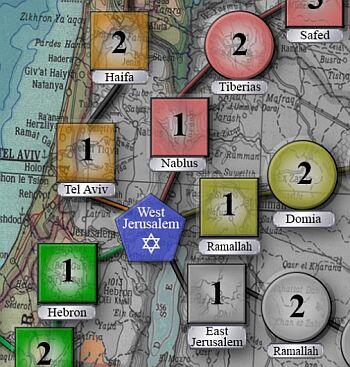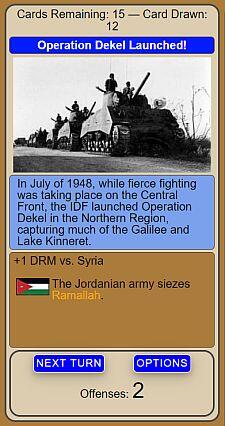
Israeli Independence: The First Arab-Israeli War, 1948-49

Israeli Independence, an introductory level solitaire wargame that tells the rich and engaging story of the First Arab-Israeli War – Israel’s War for Independence, is the second game of the Game in History Education Project. Five Arab armies, poised at the borders of the newly declared state, launch their determined invasions – and each must be pushed back in turn before any reaches West Jerusalem, the new Israeli capital.
As the headlines unfold and the vast forces of the Arab League relentlessly press forward, can you successfully allocate the precious few resources of the new Israeli Defense Force (IDF) to conduct daring offensives that will send them reeling back? Can you push the Arab legions back so far that an armistice can be achieved and these threats removed? Or will you be over-whelmed and defeated, seeing Zionist aspirations crushed?
Wargames recreate situations so that they can be studied and played, and Israeli Independence is particularly well suited to classroom use. Our thanks for Darin Leviloff's kind permission to make this game available.
Resources:
- Israeli Independence: Introduction/Tutorial (YouTube)
- Israeli Independence: Instructions(PDF)
- Israeli Independence: Game Information at BoardGameGeek
- Game files in Zip format for installation on computers (right-click and "Save as...")
- Educational Materials for Integrating the Game into the Classroom

Educational Materials to Integrate Israeli into the Classroom
Lesson 1: Understanding the Vocabulary of
- Vocabulary Sheet
Lesson 2: Understanding the Events of the First Arab-Israeli War, 1948-49
Lesson 3: The Lessons of the
Lesson 4: Understanding the Design Process for Historical Games
Lesson 5: Making Your Own Event Card
- Event Card Design Template
All education materials here courtesy of .
How to Have Students Play as a Group Online
One of the advantages of playing a boardgame in a classroom, even a solitaire game like Israeli, is that students can collaborate in pairs or even small groups. This has the advantages of ensuring that even students who are unclear about the activity or the game rules can be guided by the other students, and the students can discuss and debate both the moves to make and the events of the game. The online environment makes this more difficult, but it is certainly not impossible. We'll use Zoom an example.
Imagine you are using Zoom to teach a class of a couple dozen students synchronously. You've been discussing the end of World War II and the postwar world and introduced students to the game, but you want them to work together on the game in pairs or groups of 3 or 4. You can break students into groups on Zoom as you would normally, but before you do, identify those students who are going to be the Game Master (or GM, or Host). The Host student opens the game in their computer's browser and then shares their screen with the group. Everyone will be able to see the Host's screen with the game. (Don't forget to play fullscreen -- the "F11" key.) Students can then discuss moves and events with the Host taking the actions the group desires.
This site provides information using PDF, visit this link to download the Adobe Acrobat Reader DC software.
